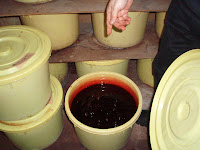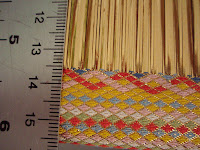It has similarities to nishiki, woven brocade. However, there is no supplemental warp with Saganishiki.
A search of the literature reveals a multitude of entries referencing the origination of the art. It was developed by the Nabeshima clan who, unfortunately, kept it secret. There was no sharing of this technique nor written history.
It is a history that has been passed down, and thus modified, as that information was exchanged.
Saganishiki was created by the Nabeshima clan around 1800 in Kashima, Saga Prefecture, Kyushu Island.
Princess Kashioka was ill and confined to her bed. She would gaze at the ceiling and asked if the ceiling design could be woven.
One of her attendants, born in Kyoto, used a paper weaving technique to recreate the ceiling design. The weaving was kept secret by the Nabeshima clan so that it could not be copied.
The first design was ajiori, a wicker pattern using paper for the warp and weft. As experience progressed, the warp remained paper but the weft was changed to silk thread.
The weaving technique waned over the years. Many members of the Nabeshima clan began to move away from Kashima in search of employment. With them, went the knowledge of the technique.
The Meiji restoration brought Japan out of the feudal era and improved the political and social structure. The Emperor Meiji revitalized the occupation of weaving. Saganishiki also began to acquire new interest and scope beyond the Nabeshima.
The greatest resurgence of Saganishiki occurred with the 1910 Japan-British Exposition in London. In order to get some recognition of his hometown Prefecture Saga, Shigenobu Okuma, a former Prime Minister, facilitated the entry of a piece of Saganishiki woven by Sagara Yoshiko. He had the weaving renamed Saganishiki to reflect Saga Prefecture. Kashima, the origination of the weave is a town in Saga Prefecture.








